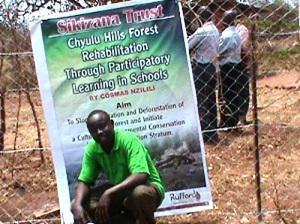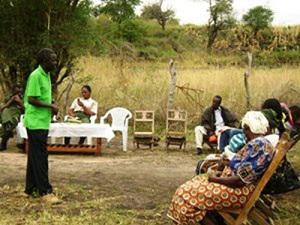Cosmas Nzilili
The aim of the project is to stop the degradation and deforestation of Chyulu forest and initiate a culture of environmental conservation across the generation stratum.

Launching Tree nursery fence at Ngomano Primary.
Chyulu hills represent the most pristine forest in this region. It is a water tower serving the coast province from the Mzima springs and the Tsavo National Park. The community has for years relied on these features for livelihood through activities that are destructive to the environment. Conservation education is seen as the best options to reducing the destruction.

Community outreach in partnership with Kenya Wildlife Service.
Methodology
The project will use advocacy through education and training, radio programmes, audio visual shows and drama in schools. This will be backed up by practical activities in form of Field visits and tree nurseries development in six schools and their environs.
The following activities will be carried out to achieve the above aims: -
1. Education and training: - This will done through lectures in schools
2. Radio programmes and talk shows
3. Audio visual shows and drama in schools
4. Development of tree nurseries in schools
Expected output
• Instil good attitude, culture and appreciation of the need to conserve our environment.
• The larger community is reached and provided forum to engage on the project issues.
• The children will be left with a long-term memory of the issues being shown or dramatized
• Demonstration sites and breeding grounds for seedlings developed for sustaining learning
Goals (Indicators of performance)
• Six environment clubs developed from 6 schools
• One weekly radio talk show for 40 weeks
• 2 Field visits per school in 12 months
• 6 indigenous tree nurseries will be started in 6 schools
• 6000 trees will be planted by end of 12 months
• 12 teachers, 18 community,18 youth leaders from 6 schools and their neighbourhood trained in forest and environment stewardship
• One location environment committee to be initiated
• Each school will make one visit to two neighbouring national parks.
Monitoring and Evaluation
1. I will maintain registers of all the participants in
• My presentations,
• Tree planting events
• Training events
• Educational Field visits
2. Photographs and film footage will be taken for all the activities
3. Radio talk shows will be recorded, and copies of CDs taken
4. No. of trees planted record will be kept per school
5. Activities of school environment clubs will be recorded and monitored